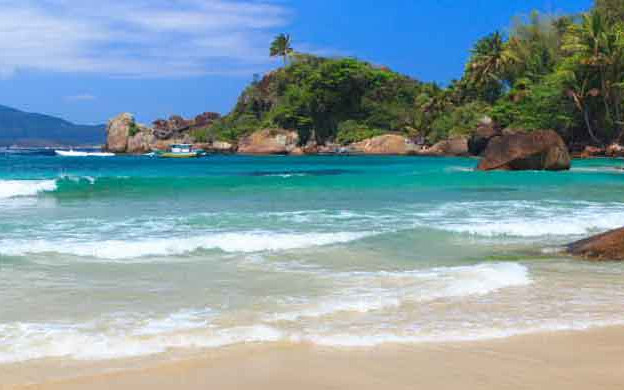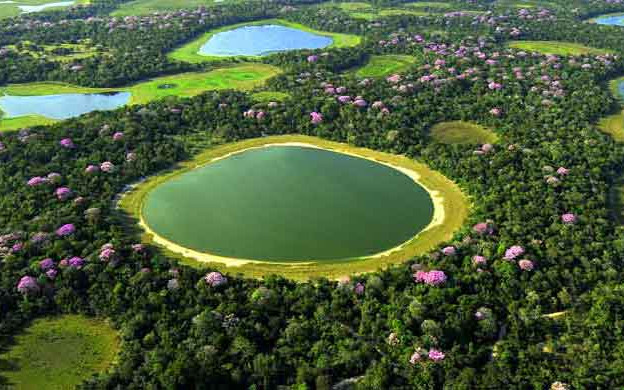Evasión tropical en Brasil
Brasil, tierra de samba y playas infinitas.
Explore un paraíso vibrante entre naturaleza y cultura.
Descubre Brasil, una aventura tropical inolvidable
Desde la inmensa llanura pantanosa del Pantanal en el estado de Mato Grosso, el reino de los jaguares, hasta Recife, la Venecia de Brasil, en la costa atlántica, desde la inmensa selva tropical amazónica al noroeste, la reserva ecológica más grande del mundo, hasta las cataratas de Iguazú (Iguaçu en portugués) en la frontera argentina, desde la arquitectura futurista de Brasilia, la capital, hasta las favelas de los barrios populares. Pero Brasil no se resume únicamente a la cachaça, sus playas de ensueño simbolizadas por las míticas playas de Copacabana e Ipanema en pleno centro de Río de Janeiro.
Brasil es también y sobre todo el producto de un formidable mestizaje en versión portuguesa entre África, Europa, Asia y la cultura amerindia. Una nación de mil colores que desfila cada año en febrero al ritmo de la samba en las calles de Río de Janeiro durante un carnaval feérico bajo el Pan de Azúcar y el Cristo Redentor (Corcovado). Un viaje a Brasil es siempre la oportunidad de impregnarse de atmósferas únicas: entre selva amazónica y ciudades con arquitectura colonial como Diamantina, pero también Fortaleza, Sao Luis, Belo Horizonte, Belem, La Diamantina, Goias, Sao Cristovao, el parque de la Capivara, el parque de la Chapada Diamantina, Praia do Forte, Natal, Itacaré, Paraty…
Un viaje cautivador al corazón de un país fascinante
Viajar a Brasil es embarcarse en el descubrimiento de un país tropical quince veces más grande que Francia, que se extiende por casi la mitad del área de América del Sur. Con tal inmensidad, no es sorprendente tener acceso a una increíble diversidad geográfica y cultural para un viaje a medida en Brasil. Ya sea en luna de miel, en familia, solo o con amigos, Brasil ofrece una multitud de experiencias inolvidables. Desde playas paradisíacas hasta las selvas exuberantes del Amazonas, pasando por ciudades vibrantes como Río de Janeiro y São Paulo, cada visitante puede encontrar su propia felicidad.

Río de Janeiro y las megalópolis
Símbolo internacional de Brasil, Río es a la vez un concentrado de Brasil y una ciudad aparte. Para simplificar, Río es para Brasil lo que París es para Francia: capital cultural, símbolo del país, una de las ciudades más bellas del mundo, con un pueblo con personalidad propia. Es un atajo que permite presentar rápidamente la ciudad en relación con el país, pero la situación es un poco más compleja. Río dejó de ser la capital política del país en 1960, cuando se inauguró Brasilia. Los funcionarios y diplomáticos han experimentado a menudo este "exilio" como una verdadera lágrima. En la actualidad, el auge del petróleo está devolviendo cierto dinamismo económico a la antigua capital. La otra megalópolis, São Paulo o Sampa, ha sido la capital económica durante casi cincuenta años. Es una de las ciudades más ricas de América Latina. Las élites industriales, políticas, industriales y financieras viajan en helicóptero. Es también un lugar de permanente efervescencia cultural y artística. Bromas recíprocas ilustran la rivalidad amistosa entre Río y Sampa. A pesar de la desaparición de sus prerrogativas, Río sigue siendo una ciudad aparte en la imaginación de los brasileños, símbolo de una suavidad y alegría de vivir inigualables. Sin embargo, algunos geógrafos están considerando la inminente unión de las dos mega-ciudades brasileñas, el hedonista de Río con la laboriosa Sampa, para formar una nueva megalópolis que hipotéticamente se extendería hasta Buenos Aires. Si los visitantes no se detienen o se detienen por un corto tiempo en Sampa, el Brasil de hoy no puede ser considerado sin su capital económica, económica y cultural en constante evolución.

Descubrimientos inusuales en Brasil
Descubrimientos insólitos en Brasil
El Pantanal, la reserva natural más hermosa de Brasil
Inundada la mitad del año, la reserva pantanosa del Pantanal, en el estado de Mato Grosso, revela todos sus encantos cuando llega la temporada seca en marzo. Este inmenso pantano, tan grande como un tercio de Francia, es el santuario de vida silvestre más grande de Brasil, el mejor lugar para observar el jaguar, pero también el jabirú, el emblema del parque, un primo de la cigüeña.
Las dunas de arena blanca del parque nacional dos Lençóis Maranhenses
Al norte de Brasil, en el estado de Maranhão, se extienden a lo largo de 1.500 km² a lo largo de la costa las dunas de arena blanca y las lagunas paradisíacas del parque nacional dos Lençóis Maranhenses. Una mancha blanca, azul y esmeralda a dos pasos del bosque amazónico. Un viaje dentro del viaje en Brasil.
Ilha Grande, el pequeño paraíso brasileño
La tranquilidad de la isla de Ilha Grande con una caipirinha al borde de los labios. Un antiguo refugio de piratas convertido en un rincón de paraíso te espera en la Costa Verde a 150 km al sur de Río. Un lugar maravilloso para nadar, bucear, hacer snorkel, descansar y hacer senderismo en la selva exuberante en una isla aún salvaje y preservada de los grandes hoteles de lujo y el turismo masivo. Un destino ideal para una luna de miel.
Tierra de carnaval y música
El célebre escritor bahiano Jorge Amado tituló uno de sus libros "El país del carnaval", subrayando la importancia de esta fiesta en la cultura brasileña, resultado de la fusión de pueblos y de las relaciones entre amos y esclavos. El carnaval de Río es la mayor manifestación popular del mundo, atrayendo a un tercio de los turistas a Brasil. Se compone de los desfiles de las escuelas de samba, los "blocos de rua" y los bailes. Durante cuatro días, el país se sumerge en una locura colectiva.
En Bahía, el carnaval se diferencia por sus "Trios eléctricos" con grupos organizados siguiendo los camiones sonoros. En Pernambuco, el frevo anima las calles de Olinda, mientras que en Minas Gerais, los músicos se mezclan con el público. La samba, emblema del país, tiene su origen en Río con sus escuelas tradicionales como Mangueira. La bossa-nova, influenciada por el jazz, ha dado a conocer mundialmente clásicos como "Garota de Ipanema" de Tom Jobim y Vinicius de Moraes.
Una población encantadora en Brasil
A pesar de la violencia social del país, relacionada con su herencia esclavista y las desigualdades sociales actuales, los visitantes pronto serán cautivados por la extrema amabilidad de los brasileños. Su necesidad de hablar durante horas, frente a una cerveza o simplemente en la puerta, es notable. La amistad de los brasileños se concede fácilmente desde los primeros encuentros. Podrás conocer a un brasileño o brasileña que te acompañará varios días como si fueras un amigo de toda la vida, solo por el placer de mostrarte su ciudad y su país.
Sin embargo, cuidado, las promesas de futuras citas no siempre se cumplen. Los brasileños también viven amistades pasajeras, especialmente en Río. Se pueden hacer amigos muy rápido, pero también perderlos igual de rápido. "A gente se fala", que equivale a nuestro "nos llamamos", significa "hasta luego... quizás". Sin duda está relacionado con las movilidades inherentes a los modos de vida antiguos de los brasileños. La noción de "país antropófago" cobrará todo su sentido al regresar al Hexágono, ya que inevitablemente estará acompañado de una intensa saudade. Por supuesto, las amistades no siempre son desinteresadas, la pobreza obliga, al igual que las miradas furtivas en Copacabana o en algunos bares para turistas. ¡Aviso a navegantes!
Una cocina mestiza y sabrosa
La cocina y la gastronomía son el reflejo de las culturas regionales y nacionales. Brasil, rico en sus influencias amerindias, africanas y europeas, ofrece una gastronomía variada. Cada región ofrece platos únicos compuestos de productos locales. En Minas Gerais, se cocina mucho con carne de cerdo y de res, papas, frijoles y otras verduras cocidas. Más al norte, la yuca, influenciada por la cultura indígena, es omnipresente. En Bahía, predominan las influencias africanas con el uso de pescado, especias y aceite de palma. La moqueca baiana, por ejemplo, requiere pescado, cebollas, pimientos y leche de coco. Platos como el churrasco gaucho o la feijoada carioca son populares en todo Brasil. En las grandes ciudades, la gastronomía brasileña se convierte en un laboratorio moderno donde se encuentran influencias locales e internacionales.
A website by
Customize your trips with Quotatrip and receive tailor-made offers directly in your inbox.
Discover a country